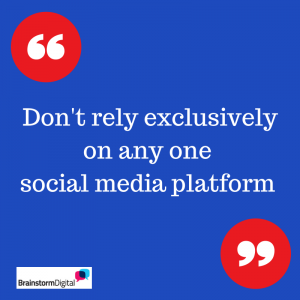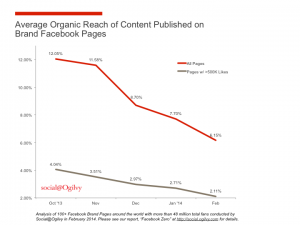 The pace of change on social media can be dizzying.
The pace of change on social media can be dizzying.
Within the last few months alone, Facebook has dramatically reduced the visibility of posts made on company pages, making ads more necessary; Twitter has changed your profile design; LinkedIn has scrapped its products and services tab, replacing it with Showcase Pages; while Google+ has suddenly, seemingly definitively, been pronounced the ‘walking dead’.
Now there’s even a rumour of a new, major Google search algorithm change in the works.
All of these changes, and many more, have had profound implications for social media marketers, who are either forced to dramatically revise their strategy, or to invest serious time and sometimes money tinkering with their profiles. Keeping on top of what’s new – let alone implementing all the necessary changes – can sometimes feel like a never-ending challenge.
So how do you keep up? Here are 7 tips that will help you deal with a fast-moving social media environment.
Accept that change is inevitable
The first step is really psychological: You need to understand that your social media profiles are not fully under your own control, and that the platforms are going to force you into changes that you do not necessarily want or need. Then, come to terms with it.
This is a truth that too many of us have not yet internalised. We think of our accounts as “ours” – and as a result are angry or frustrated when change does take place. We would all do better dealing with these changes if we can accept that we are guests on the social media platforms, and that there is going to be frequent change, whether we like it or not.
Don’t plan in detail too far ahead
Planning is, of course, the key to social media success. But just how far ahead should you look? While you need to have a general idea of where you want to be in a year’s time, a detailed schedule might be going too far.
Take, for example, Facebook. Any marketer who wrote their posts for May 2014 in November 2013 or May 2013 (as some do) would have wasted a lot of their time. In that period, Facebook has made changes to the type of content it priorities; the way it wants links to be posted; the number of times it a day it is necessary to post in order to get noticed; and forced many marketers to use ads, putting Facebook out of the reach of many small businesses.
Meanwhile, the rise of Instagram, Pinterest and Vine has opened up new opportunities that simply may not have been obvious 12 months ago.
We recommend a full schedule looking ahead 3-4 months and only a skeleton schedule further ahead than that, which gives marketers both a clear vision of where they are going – and maximum flexibility to change direction if necessary.
Revise your strategy often
Revisit your long-term social media strategy every three months. Even within that short window, there are likely to be changes that can impact your activities. If you are not going to fall behind, it’s crucial that you constantly check and re-check that you are on the right course.
Do not put all your eggs in one basket
 You must be active on more than one platform, as each one of them can change its terms and conditions at a moment’s notice – wrecking your social media programme.
You must be active on more than one platform, as each one of them can change its terms and conditions at a moment’s notice – wrecking your social media programme.
If your only social media presence was on Facebook, you may have been in serious trouble once it made organic reach virtually negligible, for example. Similarly, if you were one of the many marketers who decided to ditch Facebook in favour of Google+ over the past few months, you may be seriously regretting your decision now that Google+’s future is suddenly in doubt.
The best tactic is to use all your social media accounts to get potential clients to sign up to your email list – which is a tool that you control completely, and no social media platform can take away from you. If you see your social media presence as (largely) a means to this end, you will rely less on any one platform, and be far less vulnerable to change.
Educate yourself
Some of the changes are easy to miss, but can make a big difference to your social media programme. If you are unaware that you can now pin a Tweet to the top of your profile, for example; or that you needed to save your LinkedIn company recommendations before they were permanently erased, you’ve missed a trick.
Take at least half-an-hour each week to read up on the latest changes and trends in social media. You must stay on top of industry developments if your social media programme is going to be effective.
Don’t jump on the bandwagon
There is a lot of pressure to immediately employ whatever platform is deemed “the next big thing”. Do not feel that you need to change your strategy every time someone announces that Facebook is passé or that from now on, cool companies use Vine. That way madness lies.
Focus on what is good for your business! Make your decisions calmly, strategically and without submitting to the herd mentality. Not every change is important, not every change is necessary for you and not every change can be handled by your team, even if it’s something you actually want to implement. While you need to be flexible, it’s even more important to maintain control over your programme and not to allow yourself to lose focus.
Recognise that you will never be completely up-to-date
With changes coming thick and fast, there will always be something you missed. That’s okay! Not even the greatest social media gurus can be on top of the hundreds of social media platforms. Don’t feel overwhelmed – just do your best.
What are your tips for handling change in social media? Please share in the comments!







